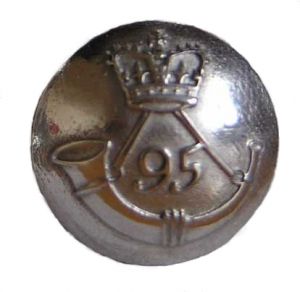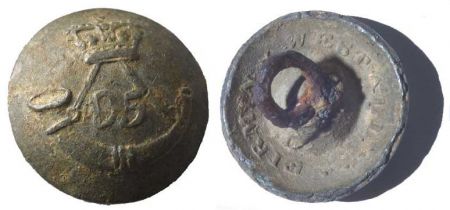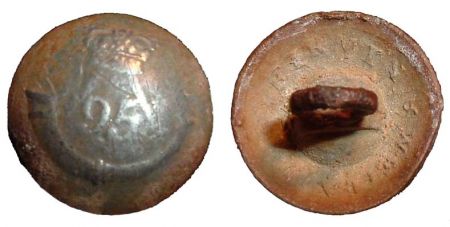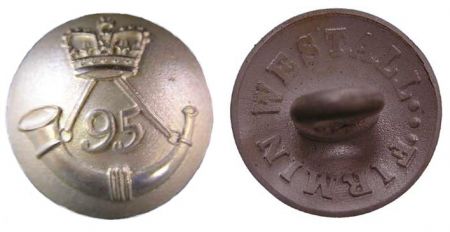
The Regimental Button of the 95th Rifles
There are many great mysteries in this world. How were the pyramids made? Why does your chewing gum lose its flavour on the bedpost over night? And did the 95th Rifles have marked buttons? Two accounts written about the 95th on campaign during the Peninsula War mention buttons;
"They had been in the habit of tearing off the buttons from their coats, and hammering them flat, passing them as English coin, in exchange for the good wine of Spain. So that, at last, the Spaniards, finding they got nothing by the exchange but trumpery bits of battered lead, they made complaints to the marshal. Halting the brigade, therefore, one day, he gave them a speech upon fraud, and ended by promising a handsome flogging to the first man he found thereafter whose great-coat would not keep buttoned in windy weather." - The Recollection of Rifleman Harris
Rifleman and Bugler William Green comments;
“One of our men a habitual drunkard could not march as he was so full of red port. Our Colonel bids the Bugle-Major to cut all his buttons off his jacket, that the French might not know what a honourable regiment he belongs to” - Where Duty Calls Me
This gives the impression that they had some sort of markings on them. Certainly the 1802 clothing regulations stated that the ordinary ranks button was a “domed button much raised in the centre with a bugle horn and crown upon it”, and as there were 48 buttons on the jacket you would have thought some would have survived. But neither the Royal Green Jackets Museum nor the National Army Museum has any examples. We in the 2nd Battalion 95th and the other 95th units in the UK and abroad have always used plain domed buttons. However, all this is about to change following a hot August bank holiday at the Folkestone Event 2003.
Whilst sweating our regimentals off at this event, a friend of ours whom we have known for a few years visited our camp, and quite calmly said “My brother has got a 95th button.” The reply that came back was slightly less cordial saying “Do F#@king What”. He answered “Yeah he found it about 20 years ago whilst working in the Dover area.” Our friend was bundled into the nearest tent to extract more information from him. Thankfully the thumbscrews and knuckledusters worked well, and a time and place was arranged to see and drool over this button.

At the allotted time and place a small group from our unit waited with baited breath for the arrival of the button. Before our friend had walked through the door he was accosted, and the small box which contained the button was removed from his person and placed on a table, and everyone gathered round. A silence came over all there, mouths were open (some dribbling); the air was filled with excited anticipation as the lid was removed and the button revealed. Amidst the gasps and awe the first words were spoken “It’s a bit small ain’t it.” Then the great fondling began. Armed with magnifying glasses we peered and stared at the button and after a short while we all agreed that this indeed was a 95th Button. But we needed this to be confirmed by an outside source.
As already mentioned the regulations stated that the ordinary ranks button is “a domed button much raised in the centre with a bugle horn and crown on it”. The button matched this description but also had the 95 in between the bugle horn cords. On the back was written Firmin and Westell. This was the maker’s name, and Firmin is still producing buttons for the military today. The button was cast from pewter with a steel ring cast into the back for fixing. We contacted Firmin with regards the 95th button. At first all they could tell us is that they did produce a button for the 95th but their archives for this button have been lost. When we told them that there was another name on the back as well (Westell) they could then date this button with confidence, as the partnership between Firmin & Westell only existed from about 1800 till about 1811. So this places our button in the right time period, as all three 95th battalions were established between 1802 – 1806.

Being well pleased with our find, we were then shocked to find out that another button had been recently found, but this time found in Spain. Again the owner of the second button was also a friend of ours and soon we had our grubby mitts all over it. Although the second button was more worn than the first it was identical in every respect. The finding of the second button in Spain confirms the fact these were the buttons used by the 95th Rifles both at home and on campaign.

Our next step was to reproduce the button. Both originals were unsuitable to make a mould from due to corrosion and wear, so a master copy had to be made from which a mould could be taken. Detailed photos and dimensions were taken from the first button and were fed into a CNC program and a wax master was machined, this was finished off by hand. From this wax master and using the lost wax casting method, a silver master was cast. From this silver master the final mould will be produced. The only change to the button we have made is replacing the steel ring with a cast one; this has been done for the ease of production and to keep the cost down.
